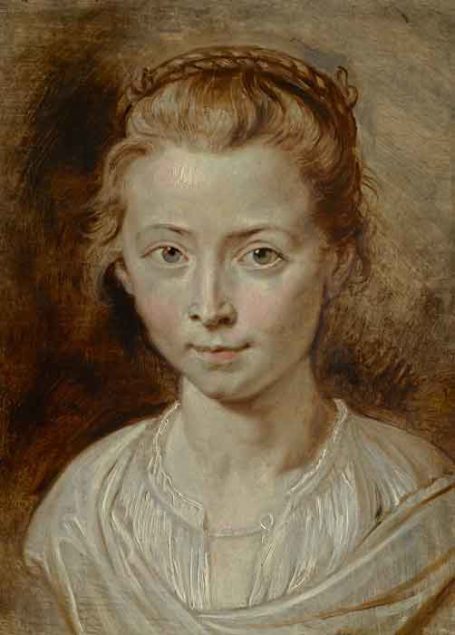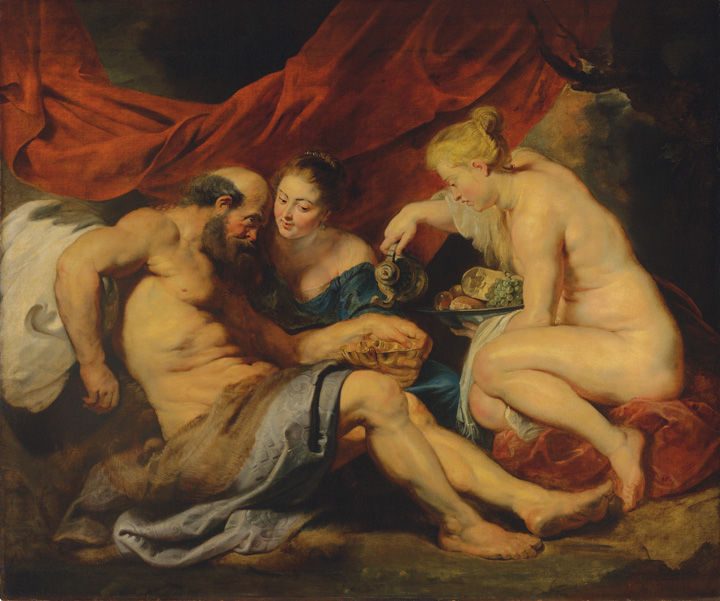
Christie’s will offer Portrait of Clara Serena , the Artist's Daughter by Peter Paul Rubens in the London Old Masters Evening Sale on 5 July, during Classic Week (estimate: £3 - 5 million ).
Never intended for public display , this
seminal work offers a rare glimpse into the private life of the greatest artist
of the Northern Baroque. The portrait is on public view in New York until 5
May, later going on view in Hong Kong from 24 to 28 May, before being exhibited
in London in the lead up to the sale .
Henry Pettifer, Head of Old Master
Paintings, Christie’s London:
“Rubens’ paintings of his family members, freer and bolder than those of his wealthy clientele, count amongst his greate st achievements in portraiture. This spontaneous likeness of Clara Serena, his only daughter with his wife Isabella Brant , painted around the time of her untimely death at the age of twelve, is extraordinary for its intimacy and timeless appeal. Its appearance on the market this summer comes after the picture has featured in recent high profile exhibitions at the Rubenshuis in Antwerp and the Scottish National Gallery, Edinburgh, and it is the first major work by Rubens to appear at Christie’s in London since the record breaking sale of

Lot and his Daughters in July 2016”THE SITTER:
The
Portrait of Clara Serena belongs with the collection of personal portraits
rendered by Rubens of his children.
Clara Serena was the beloved first child and only daughter of the artist, with his wife Isabella Brant. Little is known about her life, beyond the few intimately rendered portraits painted by Rubens, before she passed away at the age of just twelve and a half. The identification of the present portrait stems from the sitter’s resemblance to Rubens’s drawing of her mother at the British Museum and painting of Clara Serena at a younger age, in the Liechtenstein Princely Collection .
Clara Serena was the beloved first child and only daughter of the artist, with his wife Isabella Brant. Little is known about her life, beyond the few intimately rendered portraits painted by Rubens, before she passed away at the age of just twelve and a half. The identification of the present portrait stems from the sitter’s resemblance to Rubens’s drawing of her mother at the British Museum and painting of Clara Serena at a younger age, in the Liechtenstein Princely Collection .
RE
ATTRIBUTION:
In
2013, the Portrait of Clara Serena was deaccessioned by the Metropolitan Museum
of Art having been considered as by a follower of Rubens. It was only after a
subsequent transformative restoration that i t was recognized again as a
dazzling autograph work by Rubens, leading to its inclusion in the Rubens in Private
exhibition at the Rubenshuis in 2015. More recently, the picture has been the
focus of a dedicated exhibition at the Scottish National Gallery in Edinburgh
and it will be included in the forthcoming volume of the Corpus Rubenianum
Ludwig Burchard by Katlijne Van der Stighelen, due for publication in 2019.
UNIQUE
& INTIMATE :
Given the highly personal nature and unique character of this
picture , it holds a special place in Rubens’s oeuvre . Unlike any other portrait
by the artist , the picture is painted with the intimacy of his preparatory
sketches, while the face is more focused and drawn in greater detail, emitting the
great psychological compl exity of his finished portraits. The disarming
directness with which Clara Serena looks at the viewer was also not typical of contemporary
portrait painting, reflecting both the intimacy of the moment shared between
father and daughter, and displaying the deep affection with whi ch she was seen
through Rubens’ eyes. Though this picture was never intended for public
display, Clara Serena’s likeness now lives on as the private memory of the most
public artist of the Flemish Baroque.

Christ Presented to The People (‘Ecce Homo’) is considered to be among Rembrandt Harmensz. van Rijn’s (1606 - 1669) most significant achievements in any medium (estimate on request : in the region of $3 - 5million ) . One of the world’s most versatile, innovative, and influential artists, Rembrandt is viewed by many as the greatest printmaker of any generation . Epitomizing an artist at the height of his powers, both artistically and technically, this extr aordinary drypoint of 1655 dates from his t hird decade as a printmaker . Executed on a monumental scale, t he present work is one of only eight known impressions of the celebrated first state of this print and is the last known example in private hands . The other seven known impressions of this state are in major museum collections : Kupferstichkabinett der Staatliche Museen zu Berlin, The British Museum, The Metropolitan Museum of Art, The Ashmolean Museum, Bibliothèque Nationale de France, Musée du Louvre (R othschild Collection) and the Graphische Sammlung Albertina. Offered from The Collection of the l ate Samuel Josefowitz , it is on public view at Christie’s New York until 5 May ; going on view in Hong Kong from 24 to 28 May and then in London from 15 to 28 June and 30 June to 5 July , ahead of being offered for sale during Christie’s Classic Week in London, in the Old Master s Evening Sale on 5 July . Jussi Pylkkanen, Christie’s Global President : “Sam Josefowitz was amongst the greatest Old Master Print collect ors of his generation. Sixty years of connoisseurship and enthusiasm for Rembrandt led him to create an outstanding Rembrandt collection and the eventual acquisition of this masterpiece, which is the last known example of the drypoint in private hands. This impression is a celebration of the skills of Rembrandt, the master printmaker, and Sam Josefowitz, the most scholarly and respected of collectors.”
A masterful work, Christ Presented to The People (‘Ecce Homo’) is an extremely ambitious work, in technique, material and scale. The exceptional quality of this impression highlights Rembrandt ’s sophisticated command of drypoint, a technique which uses a sharp needle to scratch the design onto a copper plate. The rich, velvety line it creates is particularly expressive, but few really fine impressions are possible since printing flattens the tiny shards of copper (known as ‘burr’) which hold the ink.
Impressions on exotic papers were highly prized by collectors for their rarity, and by artist s for the way they held the ink; in this work Rembrandt used oriental paper, imported from Japan at great exp ense by the East India Company.
Global interest in the leading Old Masters continues to grow and Christie’s is proud to bring this magnificent drypoint to the open market at such an auspicious tim e. Christie’s is the market leader for works by the artist, having set the world record price at auction for Rembrandt when the oil

Portrait of a man with arms akimbo sold for £20.2 million in 2009.
The fact that Christ Presented to The People (‘Ecce Homo’) will be offered as part of Christie’s Old Master Evening Sale is a recognition of the rarity and importance of this work.

Christ Presented to The People (‘Ecce Homo’) is considered to be among Rembrandt Harmensz. van Rijn’s (1606 - 1669) most significant achievements in any medium (estimate on request : in the region of $3 - 5million ) . One of the world’s most versatile, innovative, and influential artists, Rembrandt is viewed by many as the greatest printmaker of any generation . Epitomizing an artist at the height of his powers, both artistically and technically, this extr aordinary drypoint of 1655 dates from his t hird decade as a printmaker . Executed on a monumental scale, t he present work is one of only eight known impressions of the celebrated first state of this print and is the last known example in private hands . The other seven known impressions of this state are in major museum collections : Kupferstichkabinett der Staatliche Museen zu Berlin, The British Museum, The Metropolitan Museum of Art, The Ashmolean Museum, Bibliothèque Nationale de France, Musée du Louvre (R othschild Collection) and the Graphische Sammlung Albertina. Offered from The Collection of the l ate Samuel Josefowitz , it is on public view at Christie’s New York until 5 May ; going on view in Hong Kong from 24 to 28 May and then in London from 15 to 28 June and 30 June to 5 July , ahead of being offered for sale during Christie’s Classic Week in London, in the Old Master s Evening Sale on 5 July . Jussi Pylkkanen, Christie’s Global President : “Sam Josefowitz was amongst the greatest Old Master Print collect ors of his generation. Sixty years of connoisseurship and enthusiasm for Rembrandt led him to create an outstanding Rembrandt collection and the eventual acquisition of this masterpiece, which is the last known example of the drypoint in private hands. This impression is a celebration of the skills of Rembrandt, the master printmaker, and Sam Josefowitz, the most scholarly and respected of collectors.”
A masterful work, Christ Presented to The People (‘Ecce Homo’) is an extremely ambitious work, in technique, material and scale. The exceptional quality of this impression highlights Rembrandt ’s sophisticated command of drypoint, a technique which uses a sharp needle to scratch the design onto a copper plate. The rich, velvety line it creates is particularly expressive, but few really fine impressions are possible since printing flattens the tiny shards of copper (known as ‘burr’) which hold the ink.
Impressions on exotic papers were highly prized by collectors for their rarity, and by artist s for the way they held the ink; in this work Rembrandt used oriental paper, imported from Japan at great exp ense by the East India Company.
Global interest in the leading Old Masters continues to grow and Christie’s is proud to bring this magnificent drypoint to the open market at such an auspicious tim e. Christie’s is the market leader for works by the artist, having set the world record price at auction for Rembrandt when the oil

Portrait of a man with arms akimbo sold for £20.2 million in 2009.
The fact that Christ Presented to The People (‘Ecce Homo’) will be offered as part of Christie’s Old Master Evening Sale is a recognition of the rarity and importance of this work.